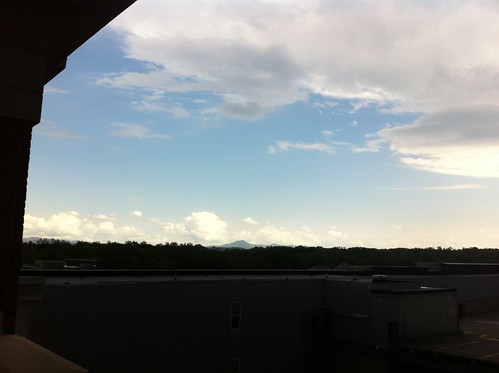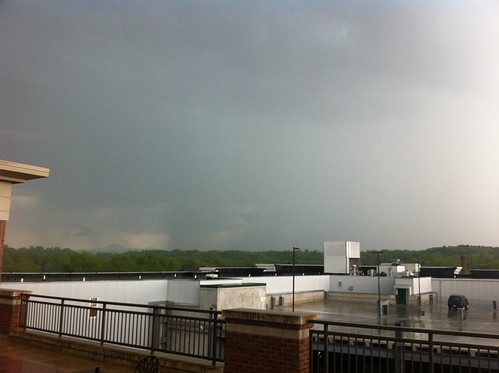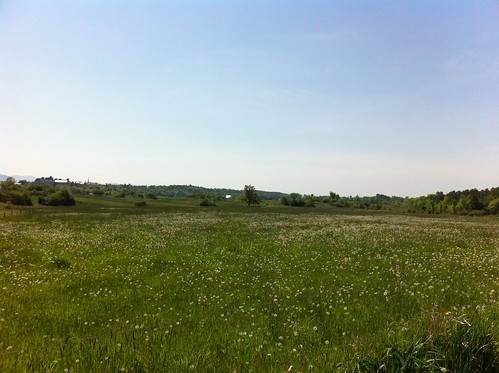On Wednesday, severe thunderstorms were in the forecast. In fact, all of Vermont was within a severe thunderstorm watch. By mid-morning, it was quite hot and humid, and it felt like perfect thunderstorm weather. Soon towering cumulus (cumulus congestus) clouds started forming over the mountains to the east.

It was not these clouds that brought the storms, but clouds moving in from the west.
I was in Winooski, and I stepped outside because I saw storms on the radar. What I saw was this very impressive cloud racing across Lake Champlain, being lit by flickers of lightning:

A severe storm passed to our north, over the Saint Albans area:

Soon after, another, even more intensive storm swept by to the south, crossing the lake somewhere near Bridport and slamming through Vergennes, Monkton, and Hinesberg, squeezing right into the narrow Winooski River valley near Richmond, and expending most of its remaining fury on Bolton Mountain.

It's a bit hard to see in the above photo, but there were definite orange-ish and green-ish hues to the cloud. Often these colors foretell hail within the storm - and in areas like the Midwest, also the possibility of a tornado. There were no tornados reported in Vermont (and indeed they are thankfully quite rare here) but there was apparently quite the hailstorm along the Chittenden-Addison county line.
There were also some very ominous looking 'scud' clouds:

Matt Sutkoski, who writes for the Burlington Free Press including the Weather Rapport blog, mentioned the scud clouds in this recent post. While these scud clouds WERE associated with a severe thunderstorm, scud clouds aren't always associated with severe weather. We often see them when storms bump up against the mountains, because they are caused by rising warm air. Sometimes you can actually watch them flow upward into the main storm cloud, and other times they quickly form and dissipate.
In Winooski, lightning was often visible, there was a bit of thunder, and we had a few surges of moderate rain. But, it never got very heavy. I was amazed when traveling home to East Middlebury later that evening, because the creeks were raging! Little Otter Creek and Lewis Creek were especially high and full of muddy water. Yet, the New Haven River was barely up at all and the Middlebury was just flowing at the normal 'slightly high' level you would expect the day after getting a half inch of rain. The ground wasn't even that wet. Of course, the oxbow cut didn't break, because the river didn't even rise.
What happened? Some severe thunderstorms come through Vermont in squall lines, hitting large areas, but these storms were very localized. See for instance the estimated precipitation map below from the National Weather Service:

(see here for the link).
You can see that Winooski was in a 'hole' that picked up almost no rain, and East Middlebury was too far south to get much out of these storms. The area in between, on the other hand, actually was hit by TWO storm cells, as you can see in this archived radar animation. If those storms had hit Ripton instead, perhaps the oxbow would have cut through.
Since Wednesday, the weather has been beautiful. This weekend, there was a festival for the newly rebuilt Crown Point Lake Champlain Bridge. The festival is near its end and the entire time there was beautiful weather.

It's in the mid 80s now, and I'm planning the first sandals-and-shorts river explore of the season after I post this blog entry. The water is still COLD but when it's 85 out, who cares? I don't think I'll jump all the way in though... yet.
The combination of rain and warm sun has turned the Green Mountain State a very vibrant green. Summer is here - or at least is close. In the next week or two, we will probably see the fireflies coming out in force. I haven't seen any in Vermont yet.. have you?


Nice write-up. Yes, there have been fireflies in my backyard for a week. They like meadows near the edge of woods, btw. :)
ReplyDeleteVery neat! I haven't seen any yet but now I will have to go look...
ReplyDeleteCharlie,
ReplyDeleteDid you know there's a *Vermont* organization competing for the $10,000 Odwalla tree prize? I was looking for California ones, and there are many; but then encountered this Vermont one and thought you might be interested to know about it.
https://cocacola.promo.eprize.com/odwallapat/gallery#
It's trying to re-plant river-side trees that were washed away by the storm Irene. It's in 12th place now, and needs to be 10th to win. (The contest is by popular vote and finishes end-May, but you can only vote once.)
- RKB
I didn't know about that! Vermont rarely wins that sort of competition, because of our small population base, but it's good to see us on there! I saw Sutro on there too - good luck!
ReplyDeleteTrees grow back really fast in the forests of Vermont, so I'm not sure if it is necessary to replant up in the national forest. Where we really need trees planted is along the rivers where they flow through farmland and populated areas. Often times there is no border of trees along a river, and of course trees are an amazing force for erosion control, so when the trees are removed the river erodes away farmland. It's hard for a farmer struggling to make ends meet to dedicate 100 feet from a river to trees... but as we have seen in Irene where there aren't trees the river may take well over 100 feet away from a farm, and there's no real way to get it back. Better to help the farmers out so they can plant and maintain trees along the river - especially fast growing riverside trees like silver maple, cottonwood, willow, etc.
Unfortunately at this point it's hard enough to keep some of the engineers from REMOVING trees from riversides, under the auspices of erosion control, which in the end pretty much always does more harm than good.